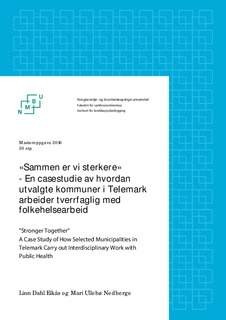| dc.contributor.advisor | Hongslo, Eirin | |
| dc.contributor.author | Eikås, Linn Dahl | |
| dc.contributor.author | Nedberge, Mari Ullebø | |
| dc.date.accessioned | 2016-08-25T11:09:44Z | |
| dc.date.available | 2016-08-25T11:09:44Z | |
| dc.date.issued | 2016-08-25 | |
| dc.identifier.uri | http://hdl.handle.net/11250/2401650 | |
| dc.description.abstract | Bruk av tverrfaglig samarbeid i kommunalt folkehelsearbeid har de senere årene fått større fokus. For å nå målet om bedre folkehelse blir tverrfaglig samarbeid sett på som en gunstig arbeidsmetode. Formålet med studien er å undersøke hvordan utvalgte kommuner arbeider tverrfaglig i folkehelsearbeidet, og forutsetninger for gode tverrfaglige samarbeid.
Oppgaven er en casestudie av tre kommuner i Telemark. For å innhente data ble individuelle intervjuer brukt, og utvalget bestod av 12 aktører med ulik fagbakgrunn som arbeider med kommunalt folkehelsearbeid. Intervjuene omhandlet blant annet spørsmål om hvordan aktørene arbeider tverrfaglig, opplevelser knyttet til tverrfaglige samarbeid, og hvilke faktorer de mener påvirker samarbeid.
Funnene viser at alle kommunene arbeider tverrfaglig med folkehelsearbeidet, men måten arbeidet organiseres på varierer. Kommunene danner tverrfaglige samarbeid ut i fra enkeltsaker, mens én kommune i tillegg har en folkehelsegruppe. Samtlige aktører var fornøyde med måten folkehelsearbeidet organiseres. Det fremkom en rekke forutsetninger for gode tverrfaglige samarbeid. Ressurser i form av tid og økonomi ble formidlet som essensielle forutsetninger, mens ledelsens prioriteringer, forankring, tydelig målsetting og kommunikasjon også ble nevnt som viktige. Et overraskende funn er at få nevnte tillit og trygghet, noe tidligere studier trekker frem som sentrale forutsetninger. Aktørene vi var i kontakt med trakk frem føringer, relevante aktører, ressurspersoner, og holdninger som essensielle, noe tidligere forskning ikke har funnet.
Til tross for at aktørene så på tverrfaglige samarbeid som hensiktsmessig kom det frem at det ikke utelukkende er positivt. Aktørene hadde erfart at de kan påta seg flere oppgaver enn de har kapasitet til og adoptere andres negative holdninger. Videre nevnte de blant annet at mangel på ressurser og lite prioriteringer fra ledelsen kan hemme samarbeid. Flere av forutsetningene som ble fremhevet er i overensstemmelse med tidligere forskning, men studien har også frembragt ny kunnskap om forutsetninger som bør være til stede for gode tverrfaglige samarbeid. | nb_NO |
| dc.description.abstract | In recent years there has been a greater focus on interdisciplinary collaboration in public health. Interdisciplinary collaboration has been highlighted as an effective strategy to promote better health. The aim of this study is to examine how selected municipalities use interdisciplinary collaboration in public health, as well as identifying which prerequisites must be present for collaboration to be beneficial.
This is a case study of three municipalities in Telemark. The study is based on data from individual interviews with 12 participants, each with different educational backgrounds, working within public health. The interviews focused primarily on how the participants use interdisciplinary collaboration in their work, as well as identifying factors that have an impact on collaboration.
The municipalities are using interdisciplinary collaboration, but the structure and organization varies. The municipalities structure the interdisciplinary collaboration based on issues within their community, while one municipality has in addition established a public health group. All the participants were pleased with the organization of the public health work. We found a number of key factors that impact interdisciplinary collaboration. Resources, both financial and in terms of time, were communicated as essential prerequisites, while the leaders’ priorities, anchoring, clear goals and communication were all mentioned as important. One finding that surprised us is that few mentioned trust, commitment or confidence. In contrast to some previous research, we found that guidance, relevant participants, “resource persons” and attitude are crucial.
The participants regarded interdisciplinary collaboration as beneficial. Despite this, it emerged that they are not viewed as solely advantageous. The participants had experienced that, in some instances, collaboration led them to undertake more tasks than they felt they had the capacity to deal with, as well as to adopt others’ negative attitudes. They mentioned that a lack of resources and prioritization from management could hinder collaboration. Several of the assumptions that were highlighted are consistent with previous research, but the study also generated new knowledge about the conditions that should be present. | nb_NO |
| dc.language.iso | nob | nb_NO |
| dc.publisher | Norwegian University of Life Sciences, Ås | |
| dc.subject | Casestudie | nb_NO |
| dc.subject | Samstyring | nb_NO |
| dc.subject | Tverrfaglig samarbeid | nb_NO |
| dc.subject | Folkehelsearbeid | nb_NO |
| dc.subject | Kommunalt folkehelsearbeid | nb_NO |
| dc.subject | Folkehelse | nb_NO |
| dc.title | «Sammen er vi sterkere» : en casestudie av hvordan utvalgte kommuner i Telemark arbeider tverrfaglig med folkehelsearbeid | nb_NO |
| dc.title.alternative | "Stronger Together" A Case Study of How Selected Municipalities in Telemark Carry out Interdisciplinary Work with Public Health | nb_NO |
| dc.type | Master thesis | nb_NO |
| dc.subject.nsi | VDP::Medical disciplines: 700 | nb_NO |
| dc.subject.nsi | VDP::Social science: 200 | nb_NO |
| dc.source.pagenumber | 85 | nb_NO |
| dc.description.localcode | M-FOL | nb_NO |
